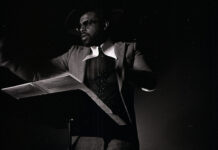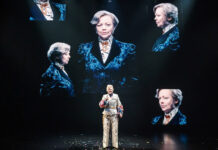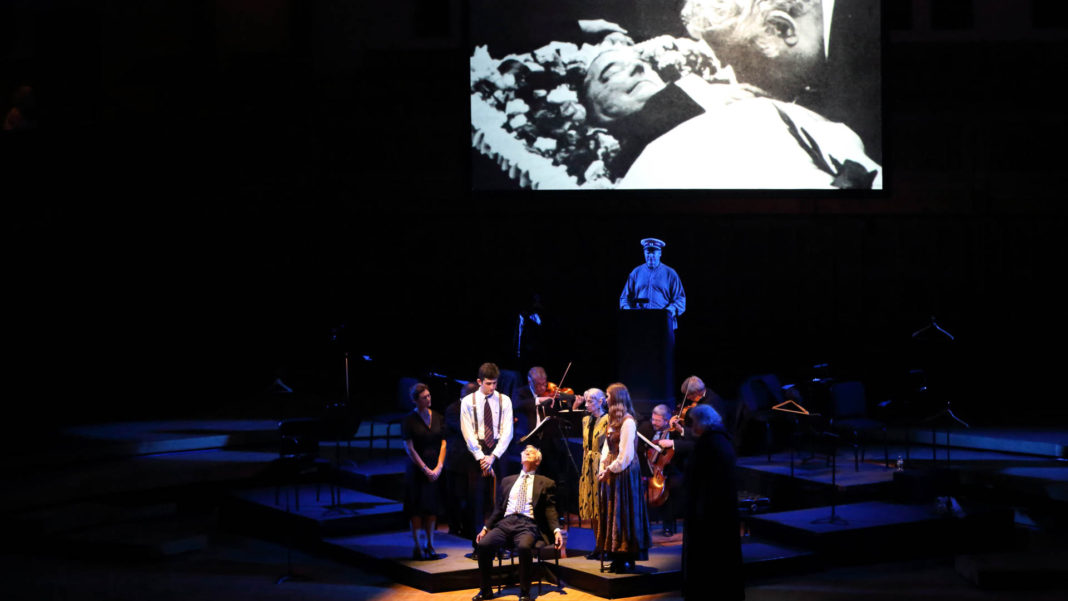We all have dream projects we hope one day to realize. For Russian composer Dmitri Shostakovich that dream was to make an opera from Anton Chekhov’s shorty story The Black Monk, which was published in 1894. He wasn’t able to do that because after Stalin came down heavily on the composer after his opera Lady Macbeth of the Mtsensk District, any plans of doing another opera were thwarted.
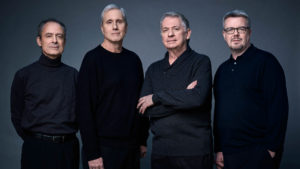
Enter The Emerson Quartet. Particularly violinist Philip Setzer. He and co-creator James Glossman decided to pair The Black Monk with Shostakovich’s 14th String Quartet to create a new theatre piece.
Shostakovich and The Black Monk combines text, acting, performance by the Quartet and visuals to tell the story of both the oppression by the Stalinist government and the story Chekhov had originally written.
The show has its West Coast Premiere on Tuesday at the Samueli Theatre at the Segerstrom Center for the Arts in Costa Mesa.

I recently spoke by phone with Setzer about this work and the Emerson String Quartet’s amazing relationship with the work of Shostakovich.
The Emerson String Quartet did a previous theatre work, The Noise of Time, that also used Shostakovich’s life and work. What makes him so inspirational for your as an artist?
I guess there are several reasons. For of all I love the music. As I was playing the quartets, I began to feel more and more when we were on stage that these quartets had a dramatic sense to them that began to feel more and more like I was in a play with four characters.
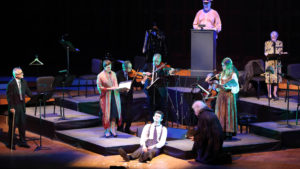
As I met my wife, Linda (who plays Irinia Shostakovich in The Black Monk), she was a huge Chekhov fan. We would go whenever there was a production of his plays. Then when we were working on The Noise of Time with Simon McBurney, his brother is one of the leading experts of Shostakovich’s music and life. He mentioned to me about The Black Monk, the story Shostakovich had planned to make another opera. I became interested and started looking into that.
Do we know why Shostakovich was obsessed with The Black Monk?
We know he loved Chekhov. I think he saw the symbolism, as it were, of the main character becoming recognized as a man of great intellect and great genius. This creative positive energy he has is fueled by this vision of this Black Monk that keeps talking to him and encouraging him. The Black Monk is both the figure of death and his muse. That’s the part of it that intrigued Shostakovich. This gray area between death and muse.
Did he begin any work on his opera?
He never wrote the opera, but he did plan it out. Lady MacBeth was successful, but then stalin saw it. Then there was an article in Pravda calling it “muddle, not music,” which is part of our show. We know Act 2, Scene 3 was going to be the scene where he loses his sanity. Then the Black Monk music. He didn’t sketch out the music, but he makes an arrangement of the Angel’s Serenade by Braga, an Italian song about a girl who hears voices calling to her. You can see why Shostakovich liked it.
I am 100%, well you can’t really be 100% sure, but 95% sure a lot of the music in his head ended up in the last two string quartets. The 14th Quartet has this Italian serenade music which I think is his alluding to the Braga and scenes in the Chekhov story. There’s this swirling music in the last quartet where the violin has this very fast passage that comes back with the cello and then all four play the same music. If those passages aren’t the Black Monk, then it’s a very strange coincidence. The last thing I would try to do would be to finish an opera for Shostakovich, but in a sense we’re trying to finish a story he couldn’t.
The Emerson String Quartet won two Grammy Awards for your recordings of Shostakovich’s String Quartets. What is it about the combination of your ensemble and this music that resonates within the four of you and by extension listeners?
I think we all love the music.We were also inspired by working with (cellist/conductor) Mstislav Rostropovich and recording Schubert with him. The whole time I was asking him one question after another. It was at that point I was becoming obsessed with Shostakovich’s music. I was asking, “What was he like? What did he say about this?” Through Rostropovich I saw Shostakovich as a real human being. Then we started looking at everything for The Noise of Time and reading all the letters, I felt like I knew him as a person.
The Borodin Quartet brought his music to the United States. I don’t want to say we were the first, but we were one of the first American quartets to say, “This is really great music. This is great art.” To have an American quartet present it with his kind commitment we honestly felt, that’s part of what made it moving.
In The Black Monk, Chekhov says “Doctors and kind relations will succeed in stupefying mankind, in making mediocrity pass for genius and in bringing civilization to ruin.” Was that a cautionary line that we’ve paid attention to or have we succumbed as a society to precisely that idea?
I think we have succumbed and we’re teetering on the edge of that. That’s partly the message of this production. That is certainly what Chekhov was talking about. It is a cautionary tale. It’s a ghost story. And Shostakovich saw that and that’s what he liked about it.
You never want to say you are making art to make a statement. But if you are making art for art’s sake, which we all should, but if there are layers of messages underneath it, it makes it more interesting and resonates in our time. We will always have these same questions. But it seems even more important at this time we’re living in.
For tickets go here.
Main Photo: Shostakovich at the Black Monk in performance at Tanglewood. Photo by Hillary Scott



